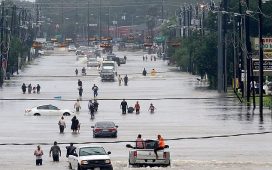We have all experienced the frustration of trying to hold a conversation in a loud pub or restaurant. Now researchers have shown that dolphins may face a similar scenario, showing that they “shout” to each other when faced with background noise.
The findings revealed that a noisy environment makes it harder for dolphins to communicate and cooperate on tasks, adding to concern about the impact of human noise pollution on marine life.
“In a very noisy pub we find ourselves increasing the volume of our voice,” said Pernille Sørensen, a graduate student at the University of Bristol and first author of the research, published in the journal Current Biology. “Dolphins respond in a similar way – they’re trying to compensate but there are some miscommunications.”
Dolphins are social, intelligent animals, relying on clicks and whistles to communicate and using echolocation to hunt and navigate. So noise generated from human activity such as drilling and shipping has a potentially harmful impact on the health of marine populations.
The latest study involved a pair of dolphins, Delta and Reese, and looked at how their ability to cooperate was affected by background noise. The dolphins were required to work together to both press their own underwater button placed at either end of a lagoon within one second of each other – a task that some humans would struggle to coordinate. They were released from a starting point during each trial, and in some trials, one of the dolphins was held back for five to 10 seconds. This meant that the dolphins had to rely solely on vocal communication to coordinate the button press.
When increasing levels of noise were played from an underwater speaker, both dolphins compensated by changing the volume and length of their calls to coordinate the button press. Nevertheless, they could not entirely compensate. From the lowest to highest levels of noise, the dolphins’ success rate dropped from 85% to 62.5%, according to the research.
The dolphins also changed their body language, reorienting themselves to face each other more frequently at higher noise levels and swimming across the lagoon to be closer to each other.
The highest noise levels were comparable with what are sometimes experienced in marine environments as a result of shipping and drilling.
“Despite their attempts to compensate, despite being highly motivated and the fact that they know this cooperative task so well, the noise still impaired their ability to successfully coordinate,” said Sørensen.
Sound travels 4.5 times faster through water than through air, meaning many marine organisms have evolved to rely on sounds to provide important cues to navigate, forage for food, avoid predators and enable communication. Invertebrates and fish hear sounds at low frequency, while cetaceans (dolphins and whales) can hear very high frequencies, up to 200Hz and also use active sonar to detect objects, including prey. Humpback whales, singing at a low frequency, can be heard up to 16,000 kilometres away.
But during recent decades, the underwater soundscape has radically changed from one that featured mostly natural sounds to one in which some regions are dominated by human noise pollution, from shipping traffic, seismic exploration, oil drilling and offshore windfarms. The increase in background noise has been linked to strandings, decompression sickness and behavioural changes.
“Those same reasons that make sound so advantageous for animals to use also make them susceptible to disturbance from noise in the environment,” said Sørensen.
In September 2020, Australia experienced the largest whale stranding recorded in history in which 450 pilot whales were found washed up on the west coast of Tasmania, most of which had to be euthanised due to their low chance of survival. Some linked the mass stranding to underwater noise pollution.
Another recent study found that when narwhals are exposed to seismic air guns, used for surveying in the oil and gas industry, they immediately begin diving to escape from the noise. These high-intensity dives use much more energy than normal and put the marine mammals’ health at risk, scientists said.
Sørensen said there had been some positive attempts to address the issue, such as the use of bubblenet structures around construction sites to muffle sounds. Some noises, such as ships engines, are more difficult to avoid, but the overall impact could be mitigated by better understanding how noise affects marine life and taking this into account. “Maybe there are times of the year that it is better not to be in a certain area,” said Sørensen. “So you could reduce traffic at certain times and increase it at others.”










